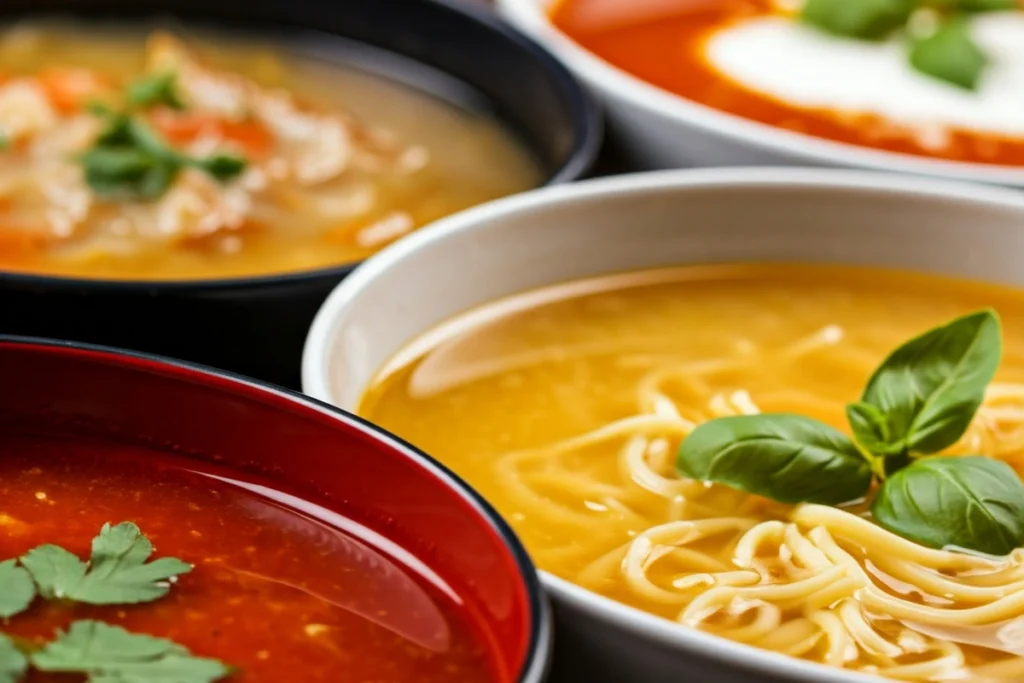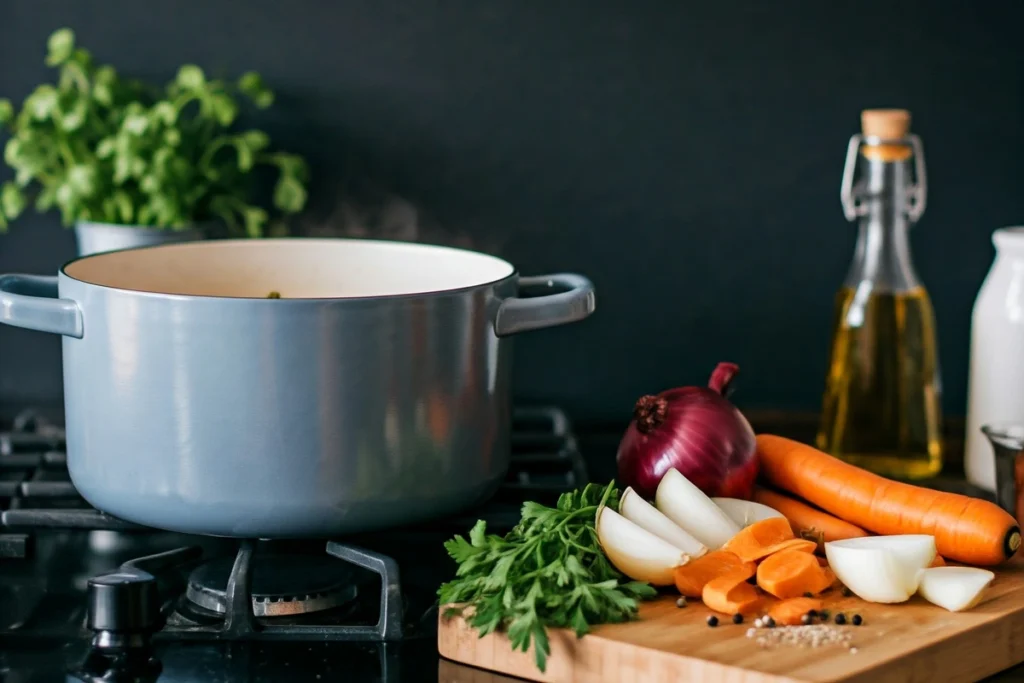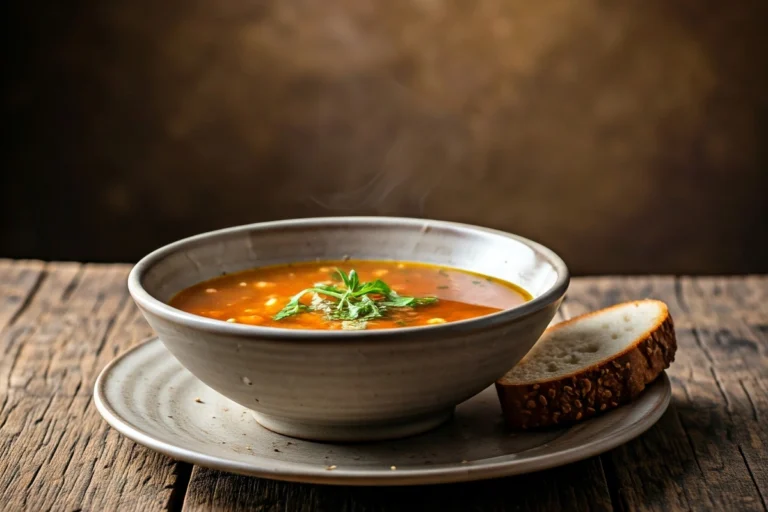Soup is more than just a warm bowl of comfort. It’s a blend of history, culture, and culinary creativity that has connected people across the globe for centuries. Whether you’re savoring a hearty chicken noodle soup on a cold winter evening or exploring exotic flavors in a spicy Thai broth, there’s no denying the universal appeal of this versatile dish. This article dives into the fascinating world of soup, exploring its types, benefits, recipes, and much more. Let’s ladle up some knowledge!
Introduction to Soup
What is Soup?
Soup is a liquid-based dish typically made by simmering vegetables, meat, or seafood in broth or water. It can range from thin, clear broths like consommé to thick and creamy varieties like chowder. This adaptability makes soup a favorite choice for countless cuisines worldwide. But what truly defines soup is its comforting ability to bring people together over a single pot.
A Brief History of Soup
Did you know that soup dates back to prehistoric times? Archaeological evidence suggests that people were making soup-like dishes as far back as 20,000 years ago. Early soups were likely simple, boiling herbs and roots in water. Fast forward to ancient civilizations, where the Greeks and Romans introduced broths, and the French perfected soups with their legendary consommés and bisques.
Over time, every culture has added its unique twist to this humble dish. From Japan’s umami-rich miso soup to India’s tangy rasam, the world of soups is a testament to the diversity of culinary traditions.
Types of Soups Around the World
Classic Soups by Region
Every region has its own spin on soup, creating a tapestry of flavors that reflect local ingredients and traditions. In Europe, classics like French Onion Soup and Italian Minestrone showcase rich, layered flavors. Asia brings umami-packed choices such as Japanese Miso Soup and Thai Tom Yum, bursting with fresh herbs and spices. Meanwhile, America’s Chicken Noodle Soup remains the ultimate comfort food, while Latin America boasts hearty creations like Mexican Pozole.
Popular Global Variations
Soup adapts beautifully across cultures. Scandinavian fish soups highlight the bounty of the sea, while Middle Eastern lentil soups are fragrant with cumin and coriander. African peanut soup offers a creamy, nutty flavor, contrasting with India’s spiced, tangy rasam. Each variation is a culinary journey, proving that soups are as diverse as the world itself.
Signature Ingredients in Regional Soups
The secret to unforgettable soup lies in its ingredients. French bouillons rely on caramelized onions and wine for depth, while Southeast Asian soups gain boldness from lemongrass, ginger, and kaffir lime. The Mediterranean uses olive oil and ripe tomatoes to infuse brightness, and Nordic soups often feature dill and smoked fish. No matter the region, ingredients tell the story of the land.

Benefits of Eating Soup
Nutritional Advantages
Soup is more than a warm meal; it’s a nutrient powerhouse. Packed with vegetables, proteins, and grains, it delivers a balance of vitamins, minerals, and fiber. A bowl of vegetable or bone broth-based soup can boost immunity, aid digestion, and even support weight management by keeping you full with fewer calories.
Soup as Comfort Food
There’s a reason soup is often associated with home and healing. Its warm, soothing nature makes it perfect for recovery, whether from a cold or a long day. Chicken soup, often dubbed “nature’s penicillin,” is not just folklore—it contains amino acids that may reduce inflammation and clear nasal passages.
Hydration and Health Benefits
Soups are an excellent source of hydration, especially brothy ones. They help replenish electrolytes, making them ideal for post-exercise recovery or during illnesses. Additionally, soups made with anti-inflammatory spices like turmeric or ginger can support overall health and reduce chronic inflammation.
How to Make the Perfect Soup
Key Ingredients for Soup
Great soup begins with fresh, high-quality ingredients. Start with a flavorful base—either a homemade broth, stock, or even a rich tomato puree. Aromatics like onions, garlic, and celery build depth, while proteins, grains, or legumes provide substance. Don’t forget herbs and spices; thyme, bay leaves, and black peppercorns are pantry staples for most soups.
Broth vs. Stock: Differences and Uses
Although often used interchangeably, broth and stock have key differences. Broth is made by simmering meat, offering a lighter flavor, while stock uses bones for a richer, gelatinous texture. Each suits different recipes—use broth for clear soups like consommé and stock for hearty options like chicken noodle soup.

Step-by-Step Guide to Soup Preparation
- Start with Aromatics: Heat oil or butter and sauté onions, garlic, or other aromatics.
- Add Base Ingredients: Pour in broth or stock, followed by proteins and hearty vegetables.
- Simmer and Season: Let the soup simmer gently to meld flavors. Add salt and spices gradually.
- Finishing Touches: For creamy soups, blend until smooth; for brothy soups, garnish with herbs.
Tips for Enhancing Flavor
- Roast vegetables before adding them to your soup for a caramelized depth.
- Add a splash of acid (like vinegar or lemon juice) at the end to brighten the flavors.
- Stir in fresh herbs just before serving for a pop of freshness.
For a selection of delicious and creative recipes, visit Goldy Recipe’s Recipe Guide.
Classic Soup Recipes to Try
Chicken Noodle Soup
This timeless favorite combines tender chicken, soft noodles, and a flavorful broth. Begin with a mirepoix of carrots, celery, and onions, then simmer chicken thighs in a savory stock until tender. Add egg noodles and cook until al dente. Finish with fresh parsley and a squeeze of lemon for brightness.
French Onion Soup
A French classic, this soup is all about caramelized onions and a rich beef broth. After cooking the onions to a deep golden brown, deglaze with wine and add the broth. Serve with toasted baguette slices topped with melted Gruyère cheese.
Tomato Basil Soup
This creamy, tangy soup is a favorite for pairing with a grilled cheese sandwich. Start with roasted tomatoes, garlic, and onions, then blend with fresh basil and cream. It’s simple yet satisfying.
Vegan and Vegetarian Options
Plant-based soups can be just as hearty and flavorful. Lentil soup offers protein-packed sustenance, while roasted butternut squash soup provides a sweet, earthy alternative. For more vegetarian ideas, explore Goldy Recipe’s Vegetarian Delights.
Specialty Soups and Trends
Gluten-Free Soups
For those avoiding gluten, there’s no shortage of delicious options. Many broths and stocks are naturally gluten-free, and grains like quinoa or rice can replace wheat-based noodles. Classic examples include chicken and rice soup, or minestrone made with gluten-free pasta. Always check labels for hidden gluten in store-bought broths.
Keto and Low-Carb Soups
Keto-friendly soups rely on low-carb vegetables like cauliflower, spinach, or zucchini. Creamy cauliflower soup, blended with cheese and herbs, is a satisfying choice. Another option is creamy chicken and mushroom soup, made without thickeners like flour or cornstarch. These soups are rich, hearty, and perfect for staying on track with your goals.
Fusion and Contemporary Soup Recipes
Modern culinary trends have given us exciting fusion soups. Think ramen with Mexican flavors or pho-inspired chicken noodle soup. These dishes mix traditional bases with bold, unexpected spices and toppings, making them a hit at trendy restaurants and home kitchens alike.
Soup Storage and Reheating Tips
Storing Soups Safely
Proper storage is key to keeping your soup fresh and safe. Allow hot soup to cool to room temperature before transferring it to airtight containers. Store in the refrigerator for up to four days, or freeze for up to three months. For soups with cream or dairy, consume within a shorter time frame, as these ingredients don’t freeze as well.
Reheating Techniques for Different Soups
When reheating soup, use low to medium heat on the stovetop for even warming. Avoid boiling soups with dairy, as this can cause curdling. For thick, blended soups, add a splash of broth or water to restore the desired consistency. Microwave reheating is also an option; heat in short intervals, stirring between sessions to prevent uneven heating.
Maximizing Shelf Life
For soups with fresh herbs or delicate toppings, store these separately and add them just before serving. This keeps flavors vibrant and prevents ingredients from becoming soggy. Freezing soups in portion-sized containers also makes for convenient, no-waste meals.
FAQs About Soup
What is the Difference Between Soup and Stew?
Although soup and stew share similarities, the main difference lies in their consistency. Soups are typically thinner, with more liquid, while stews are thicker and heartier, often featuring larger chunks of meat and vegetables. Another distinction is cooking time—stews are simmered longer, allowing flavors to intensify.
Can You Freeze Soup?
Yes, most soups freeze well, making them a convenient meal prep option. Broth-based soups like chicken noodle or minestrone freeze best, while creamy soups may separate when thawed. To freeze soup, allow it to cool completely, pour it into airtight containers, and label them with the date.
How Do You Fix Overly Salty Soup?
If your soup is too salty, don’t panic. Add a raw potato to absorb some of the salt, or dilute the soup with unsalted broth or water. You can also balance the flavors by adding a splash of acid, like lemon juice or vinegar, or a touch of sugar.
Top Tools and Equipment for Soup Lovers
Best Pots and Pans for Soups
A quality soup pot is essential for any kitchen. Look for a large, heavy-bottomed pot that distributes heat evenly, such as a Dutch oven or stainless steel stockpot. For smaller batches, a medium-sized saucepan works well. Non-stick pots can also make cleaning easier.
Must-Have Kitchen Gadgets
Investing in the right tools can elevate your soup-making game. An immersion blender is perfect for pureeing creamy soups directly in the pot, saving time and cleanup. A fine-mesh strainer is handy for clear broths, while a ladle is indispensable for serving.
Essential Ingredients to Keep in Your Pantry
Stock your pantry with soup staples to whip up a comforting bowl anytime. Keep dried herbs, spices, and bouillon cubes on hand for flavor. Canned tomatoes, beans, and coconut milk are versatile additions, while lentils, barley, and pasta make soups hearty and filling.
With these tools and tips, you’ll always be ready to create a delicious soup from scratch!
Conclusion
Soup is more than just a meal—it’s a comforting tradition, a nutritional powerhouse, and a creative canvas for flavors from around the world. Whether you’re sipping on a warm bowl of chicken noodle soup during winter or exploring the bold spices of a Thai-inspired broth, soup has a special way of nourishing both body and soul.
From learning about its fascinating history and diverse types to perfecting your own recipes and understanding storage tips, this guide equips you to enjoy soup in all its glory. With the right tools, ingredients, and techniques, you can transform simple components into something truly extraordinary.
So, why not ladle up a bowl today? Let your kitchen become a space for experimentation, and who knows—you might just create a new family favorite!

